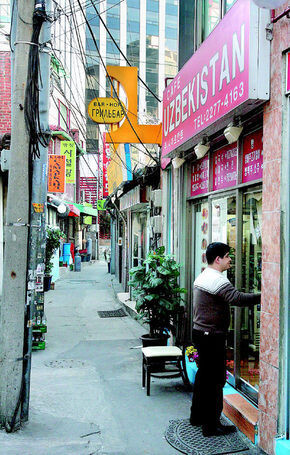hankyoreh
Links to other country sites 다른 나라 사이트 링크
Seoul’s foreign neighborhoods take root

It is said that South Korea is the only country where a Chinatown could not take root. Indeed, in what is by some statistics the world’s most homogenous country, the presence of foreign communities has been hard to come by.
But the face of modern Korea is changing. International marriages are on the rise. And according to data released by the National Statistical Office (NSO), as of the end of 2005, the number of registered foreigners was about 485,000, accounting for over 1 percent of the population, compared to just 0.1 percent in 1992 and 0.53 percent in 2002. Foreign residents in Seoul alone numbered about 130,000 at the end of last year, a sharp increase from just over 50,000 only decade prior. Accordingly, foreign neighborhoods have been popping up in greater number.
Walk through a 200-meter alley between Euljiro and Gwanghui-dong in Jung-gu, and you can easily tell you are not in an ordinary Korean neighborhood. Mustachioed men wearing fur hats and long coats can be seen walking alongside stylish blondes on this so-called "Russian street," which was established by Russian merchants in the mid-1990s. This district provides these Russians a one-stop shopping district, where they can do everything from purchasing goods to mail home, finding apartments to rent, and enjoying home-style cooking, all in their mother tongue.
There also is a "Mongolian town" to the north of "Russian street." A 10-story building features Mongolian restaurants, travel agencies, trading companies, and supermarkets. A Mongolian immigrant who will open a cafe in the district said, "Here, it is no big deal if you can’t speak Korean."
As the value of the Won dropped precipitously during the Asian financial crisis of 1997-98, immigrant workers from Central Asian nations like Uzbekistan and Mongolia began to come to Korea in greater numbers, as it had become more affordable. Many of those workers opted to stay, opening shops and restaurants.
Southwest of the Mongolian and Russian districts, nearby Itaewon subway station, shops and restaurants catering to African immigrants stand in a row. There is a "Nigerian alley" in this district; a restaurant that opened there about two years ago sees not only Nigerian customers, but about 15-20 customers daily from Ghana and Ethiopia, as well.
Another "African street" can be found near Noksapyeong subway station, this district catering to North African clients. An owner of a Moroccan restaurant in the district said, "I want to introduce the food and culture of Morocco to South Korea and to use this house as a meeting place of Europeans and Americans as well as North Africans." He plans to move his restaurant behind the Hamilton Hotel in Itaewon next month. According to the owner, he does not see many Central African customers, something he attributes to difference in culture and religion between the two regions.
Seoul also has an upscale French village in Seorae Maeul, Seocho-gu. About 20 percent of Korea’s French residents, or more than 450 people, live here. The main road of this village is called Montmartre Street. Blocks of three colors symbolizing <
This area is relatively quiet, though a love of vinificatory culture has begun to permeate. In the evening, the district’s myriad wine bars begin to bustle with revelers. According to a French resident that has lived in this village for 20 years, "This area used to be a quiet neighborhood, but a number of restaurants and wine bars have been opened for the past four or five years."
Editorial・opinion
![[Column] Park Geun-hye déjà vu in Yoon Suk-yeol [Column] Park Geun-hye déjà vu in Yoon Suk-yeol](https://flexible.img.hani.co.kr/flexible/normal/500/300/imgdb/original/2024/0424/651713945113788.jpg) [Column] Park Geun-hye déjà vu in Yoon Suk-yeol
[Column] Park Geun-hye déjà vu in Yoon Suk-yeol![[Editorial] New weight of N. Korea’s nuclear threats makes dialogue all the more urgent [Editorial] New weight of N. Korea’s nuclear threats makes dialogue all the more urgent](https://flexible.img.hani.co.kr/flexible/normal/500/300/imgdb/original/2024/0424/7317139454662664.jpg) [Editorial] New weight of N. Korea’s nuclear threats makes dialogue all the more urgent
[Editorial] New weight of N. Korea’s nuclear threats makes dialogue all the more urgent- [Guest essay] The real reason Korea’s new right wants to dub Rhee a founding father
- [Column] ‘Choson’: Is it time we start referring to N. Korea in its own terms?
- [Editorial] Japan’s rewriting of history with Korea has gone too far
- [Column] The president’s questionable capacity for dialogue
- [Column] Are chaebol firms just pizza pies for families to divvy up as they please?
- [Column] Has Korea, too, crossed the Rubicon on China?
- [Correspondent’s column] In Japan’s alliance with US, echoes of its past alliances with UK
- [Editorial] Does Yoon think the Korean public is wrong?
Most viewed articles
- 1[Guest essay] The real reason Korea’s new right wants to dub Rhee a founding father
- 2Why Korea shouldn’t welcome Japan’s newly beefed up defense cooperation with US
- 3[Column] ‘Choson’: Is it time we start referring to N. Korea in its own terms?
- 4New AI-based translation tools make their way into everyday life in Korea
- 5[Column] Park Geun-hye déjà vu in Yoon Suk-yeol
- 6Senior doctors cut hours, prepare to resign as government refuses to scrap medical reform plan
- 7Opposition calls Yoon’s chief of staff appointment a ‘slap in the face’
- 8Will NewJeans end up collateral damage in internal feud at K-pop juggernaut Hybe?
- 9Terry Anderson, AP reporter who informed world of massacre in Gwangju, dies at 76
- 10Thursday to mark start of resignations by senior doctors amid standoff with government